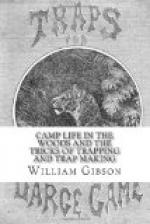the two strips on each side, and sewing around the
whole with a winding stitch, exactly after the manner
of the edge of an ordinary palm-leaf fan. The
inside of the canoe should now be lined with long strips
of cedar running through the entire length of the boat
if possible, but if not, should be so cut as to neatly
overlap at the ends. These pieces should be an
inch or two in width, and from a quarter to half an
inch-in thickness. The ribs are then to be put
in. These are generally made from ash, one or
two inches in width, and [Page 263] a quarter of
an inch in thickness. Any light flexible wood
will answer the purpose, and even barrel hoops when
attainable will do very well. These ribs should
be bent to fit the interior of the canoe crosswise,
either close together, or with equal distances between
them and the ends should then be firmly secured beneath
the gunwales by a continuous loop-stitch through the
bark. For a canoe of twelve feet in length, the
width should be about two feet, and in order to keep
the gunwales firm, two or more cross-pieces should
be inserted, and lashed firmly at their ends as our
illustration shows. The centre third of the length
of the canoe should be parallel at the sides, and
if two braces, two feet in length are placed at each
end of this third, the shape will be about perfect.
We now have a bark canoe of considerable strength
and durability, and it only awaits to be made water-proof
for final use. In order to accomplish this all
the seams outside, and the entire interior of the
canoe should, be smeared with pitch, after which its
floating qualities may be tested with confidence.
Should any leaks occur their where-abouts are easily
detected, and an additional application of pitch will
remedy the difficulty. The Indians in sewing their
bark canoes use tamarack roots, fibrous plants, and
grasses, in lieu of thread, and even with these inferior
materials often attain to such perfection in compact
sewing, as to render the use of pitch unnecessary
for water-proof purposes. Such skill is rarely
attained by the white man, and the art of making a
water-proof canoe, even out of a single piece of bark,
is by no means an easy task without the aid of tar
or pitch.
[Page 264] For the trapper we strongly recommend the birch “bark.” With the above directions we are sure no one could go astray, and we are equally sure that a canoe made as we describe, would present advantages of lightness and portability which no other style of boat would possess. For temporary purposes, canoes can be made from basswood, hemlock, or spruce bark; but they are at best, very rude and clumsy in comparison with the birch bark. They are generally made after the principles of the above described; either sewing or nailing the edges of the bark together, and smearing every joint and seam profusely with pitch, and adding gunwales, lining, and ribs.




